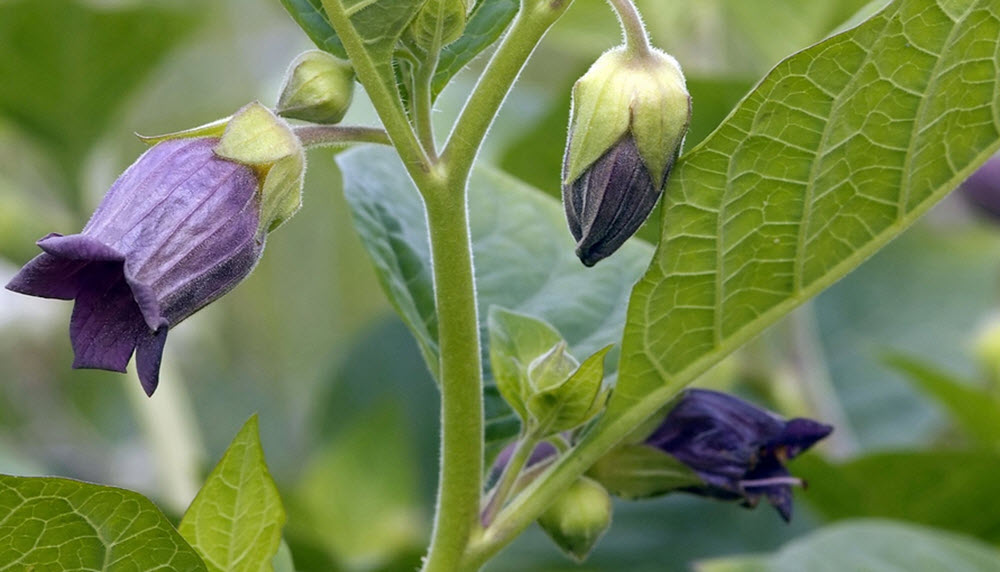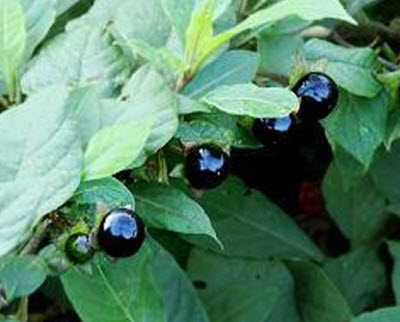Contents
Atropa belladonna, known in English as deadly nightshade or just belladonna, is a perennial plant belonging to the same family as tomatoes, potatoes, and eggplant. Both foliage and berries contain tropane alkaloids and are very toxic when ingested. Yet, the plant has a long history of use in medicine and cosmetics.
In Italian, bella donna means beautiful woman. Historically, eye-drops containing belladonna has been used by women wishing to dilate their pupils to appear more seductive.
The genus name Atropa is named after the Greek goddess Atropos, one of the three Greek fates who determines the destiny of each human through their weaving.

Scientific classification
| Kingdom | Plantae |
| Order | Solanales |
| Family | Solanaceae |
| Genus | Atropa |
| Species | Atropa belladonna |
Geographical range
Atropa belladonna is native to Europe, northern Africa, and western Asia. It grows wild from the United Kingdom in the west to Ukraine and Iran in the east.
Today, it has been naturalized in other parts of the world, including North America.
Toxicity
 All parts of the plant, including foliage and berries, contain tropane alkaloids, including atropine, hyoscine (scopolamine) and hyoscyamine, and are very toxic when ingested. Belladonna is one of the most toxic plants in the Eastern Hemisphere.
All parts of the plant, including foliage and berries, contain tropane alkaloids, including atropine, hyoscine (scopolamine) and hyoscyamine, and are very toxic when ingested. Belladonna is one of the most toxic plants in the Eastern Hemisphere.
Atropine, hyoscine, and hyoscyamine have anticholinergic properties, which means that they can block the neurotransmitter acetylcholine in the central and peripheral nervous systems. This is why belladonna poisoning can be deadly; it disrupts the body’s ability to regulate activities such as heart rate and breathing.
The part of the plant that has the richest concentration of tropane alkaloids is the root, followed by the leaves, stalks, and flowers, in that order. While roots have up to 1.3% tropane alkaloids, ripe berries typically have just 0.7%, flowers 0.6% and seeds 0.4%. This does NOT mean that ingesting seeds, flowers, or berries are safe. In 2009, an adult woman developed serious symptoms after eating six belladonna berries.
The effects of belladonna are unpredictable.
Examples of symptoms of belladonna poisoning
- Dilated pupils (which in turn causes sensitivity to light)
- Blurred vision
- Rash
- Flushing
- Severely dry mouth and throat
- Urinary retention
- Constipation
- Headache
- Tachycardia (a heart rate that exceeds the normal resting rate)
- Loss of balance
- Slurred speech
- Confusion
- Delirium
- Hallucinationations
- Convulsions
The antidote for belladonna poisoning
Physostigmine or pilocarpine
Atropine
In medicine, atropine is used for several different purposes:
- Treating certain types of nerve agent and pesticide poisonings (atropine typically administered as an injection)
- Treating certain types of slow heart rate (atropine typically administered as an injection)
- Decrease saliva production during surgery (atropine typically administered as an injection)
- Eye drops containing atropine is used to treat uveitis.
- Eye drops containing atropine is used to treat early amblyopia.
Atropine is found in a number of plants of the nightshade family, including belladonna, mandrake, and jimsonweed. The compound was first isolated in 1833. Today, it is included in the WHO’s List of Essential Medicines.
Hyoscine (Scopolamine)
Hyoscine, also known as scopolamine, is found in certain medicines used to treat:
- Motions sickness
- Nausea and vomiting after surgery
It can also be administered prior to surgery to reduce saliva production during the surgical procedure.
Hyoscine is typically administered as an injection. In some cases, it is taken orally instead or as a skin patch.
Hyoscine is found naturally in nightshade plants, such as belladonna and henbane. It is included in WHO’s List of Essential Medicines.
Hyoscyamine (daturine)
Hyoscyamine, also known as daturine, is a secondary metabolite found in certain members of the nightshade family, such as belladonna, henbane, mandrake, and jimsonweed. Since it is the levorotary isomer of atropine, it is sometimes referred to as Levo-atropine.
In medicine, hyoscyamine can provide symptomatic relief of spasm caused by various lower abdominal and bladder disorders, such as pancreatitis and interstitial cystitis. It can also reduce some of the symptoms of Parkinson’s disease, relieve certain heart problems, and help manage respiratory issues and mucous secretions in patients with lung disease.
For people suffering from chronic pain, especially in palliative care, hyoscyamine can increase the quality of life, especially when combined with opioids.
History of belladonna use
In English, the plant is known as deadly nightshade, and that is an apt name since even a small dose of this plant is enough to kill a human adult. Historically, the plant has been used as a deadly poison, but also for more benign purposes in medicine and cosmetics.
Toxin
Humans have long known about the toxicity of belladonna, and early humans used the plant to make toxic arrows.
In Ancient Rome, belladonna was known for its deadliness, and Agrippa the Younger, wife of Emperor Claudius, is one example of a person rumored to have used the poison to commit murder.
If we look at the Medieval period, Lieutenant Macbeth from Scotland used deadly nightshade to poison the troops of the invading Harold Harefoot, King of England. This caused the English to retreat, and Macbeth eventually became King of Alba, a part of modern-day Scotland.
Beauty
When the eyes are exposed to eye-drops containing belladonna, the pupils dilate, because the drops block receptors in the muscles of the eye that constrict pupil size. During periods when large pupils were considered beautiful and seductive, some women used belladonnato achieve this effect.
Medicinal uses
Belladonna has a long history of being used as a pain reliever, muscle relaxant, and anti-inflammatory herbal medicine. Before the Middle Ages, belladonna was used in Europe as an anesthetic for surgical procedures.
As late as the 1930s, cigarettes with belladonna leaves soaked in opium tincture were prescribed by physicians in the United States. The combination of belladonna and opium is very effective against certain forms of visceral pain. Both these plants where were commercially available to retail customers at this point in time and belladonna was a commercially grown plant. The plant was not of high economic importance and now has close to no economic importance other than as a rare decorative plant.
What are Binary options
Binary options are a type of financial instrument that allows you to speculate on whether the value of a certain asset, such as stocks or commodities will go up or down in value. If you are right then you earn a high return. If you are wrong you lose your entire investment. Some binary options will give you a return of more than 500% if you are right but most will give you a return of just below 100%. Learn more about binary options.
Binary options trading is a type of high-risk, high-reward trading. You risk losing all the money you invest. Do not trade with binary options if you can not afford to lose your money. Skilled traders can earn a lot, but a high percentage of beginners lose money.
Twilight sleep (Dämmerschlaf)
In the late 1800s, Doctor Schneiderlin recommended the use of a combination of hyoscine and morphine for surgical anesthesia. In 1902, Richard von Steinbuchel proposed that it could be used to relieve pain during childbirth, and this idea was further developed by Carl Gauss in Freiburg, Germany.
Eventually, injecting the woman with a combination of hyoscine and morphine during labor became known as the Freiburg method or Dämmerschlaf, a German word meaning twilight sleep. The injection produces an amnesic condition where the person is conscious but insensitive to pain. According to some reports, it didn’t actually relieve pain, it just made the woman forget about the pain afterward. The method was used in the United States until the end of the 1960s.
Recreational drug use
Atropa belladonna has been used as a recreational drug by those seeking the delirium and hallucinations, but it has never been a widespread or very popular drug, for several reasons.
Belladonna is notoriously difficult to dose, the risk of a fatal overdose is high, and the effects are unpredictable. Also, the hallucinations are often of a very unpleasant nature, being described by various users as dark, demonic, frightening, threatening, and generally terrifying. Visual hallucinations can continue for several days after consumption.
